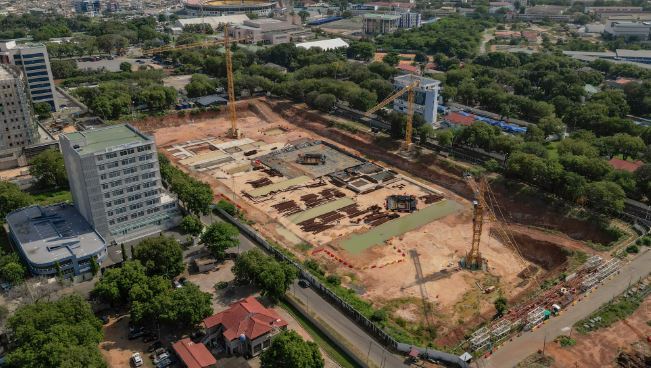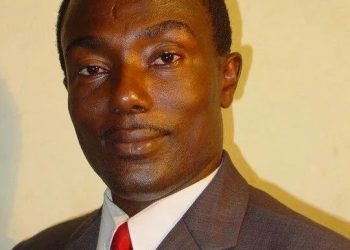Ghana’s National Cathedral Project commenced as a promise by the President, Nana Akufo-Addo, to some portions of the Christian faith during the campaigning period towards his presidency. This promise resonated with portions of the Christian faith, and having been elected President in 2016, there was a need to fulfil the promise of building the national cathedral.
This article will present an overview of controversies concerning the National Cathedral, how Cathedrals were funded in the mediaeval age, and finally how blockchain technology could have prevented the flooding scandals associated with the National Cathedral.
Controversies surrounding the National Cathedral commenced when the land area for the project was demarcated. The site located at Ridge in Accra tends to be an area with existing buildings that served as residence to nine (9) Court of Appeal Judges in Ghana. The catchment area for the demolition also had several buildings, including the Scholarship Secretariat, Judicial Training Institute, and Passport Office.
This triggered public interest in the National Cathedral Project and later worsened when it was made known that the Nine Judges would be relocated to a rented apartment while the government constructed a new bungalow to accommodate them [1].
The contention included whether the National Cathedral Project was being funded by the state (which would need parliamentary approval) or one that would be funded by private funds. Was the state setting its priority, right? Does Ghana need a Cathedral now? In a secular state like Ghana, it is trite that such a project did not have the support of taxpayers from various religious beliefs.
The dissenting views among the diverse Christian majority in Ghana were made clear subsequently that the state only contributed land for the construction of the project and that the cathedral would be funded from voluntary mobilisation.
President Nana Addo then took the step to donate GHS100,000 when he launched the fundraising campaign for the National Cathedral Project [2]. The public was encouraged to voluntarily donate [3] to support the National Cathedral Project through a mobile money short code (*979#) and three different bank account details displayed on the National Cathedral of Ghana website [4]. The sceptics were relaxed as funding for the project was made voluntary. This was understandable because it became clear how the National Cathedral would be funded.
It is important to note that every Cathedral has a history surrounding it, which makes it deserving of preservation. Accordingly, a National Cathedral with a vision of serving as a place of worship and reflection, linking people to their culture, as well as serving as a tourist attraction does not need a national controversy surrounding it.
This is not the case in Ghana, as the building of the National Cathedral has become more or less scandalous. The uncertainty regarding the cost of construction is the first thing to worry about [5]. The minister of finance, Mr. Ofori-Atta, mentioned the cost to be $100 million in 2019. The secretary to the Board of Trustees of the National Cathedral, Victor Kusi Boateng, is cited for estimating the budget to be $200 million in 2021. In June 2022, the finance minister in an interview estimated the cost to be $350 million at the same time the lawyer for the construction firm revealed that his team had finalised a $400 million contract for a cathedral project in Ghana in an interview with Legal500.
Again, the National Cathedral project hired Sir David Adjaye and Associates [6] for consultancy services on new bids opening for Ghs32 million but, in the end, awarded the project to his construction firm. Then there was Sonnie Badu, a gospel musician, who denied having received any payment in a tweet when it was reported that he was paid $50,000 for his performance at the launch of the national cathedral.
Currently, the order by the finance minister to the Controller & Accountant General to pay GHS25 million as additional seed money is contrary to what the populace was made to believe that the cathedral was being funded without state funds [7]. The national cathedral project has been frequented by the inflow of scandals and has moved from national controversy to begging for God’s mercy.
How do we build a Cathedral without Controversy?
The answer to this can be determined if we inquire into the practices of the mediaeval ages in building and funding a cathedral. Medieval Cathedrals were at a high scale that amazes us when looking back.
The Durham World Heritage Site [8] noted that the construction of the Cathedral was an expression of faith and a channel for the creative energy of mediaeval European society. The financing of the Cathedral was a community effort championed by senior clergy and bishops who made significant contributions.
There were many funding sources for the lavish and monumental cathedrals, including contributions from the congregation, the selling of objects lasting from earlier years, especially objects of historical interest, and gifts from kings, but never did the building of Cathedrals have a single source of funding or come from a handful of people.
The scholarly study of Financing Cathedral Building in the Middle Ages: The Generosity of the Faithful by Wim Vroom was first published in 1981 in his native language, Dutch, and later translated.
His study relied on the surviving fabric records of about eighty cathedrals that were constructed during the late part of the Middle Ages.
Vroom noted that bishops and cathedral chapters were responsible for paying the expenses of a cathedral and the fund was drawn from every imaginable funding source that could be identified. The list outlined by Vroom included gifts from founding bishops and cathedral chapters who were saddled with the responsibility of paying construction expenses; initiation fees charged on members (canons); gifts from popes, kings, and other secular rulers; tithes levied on churches within the jurisdiction of the cathedral in question; gifts given by pilgrims; profits from fairs, including major feasts; and other sundry sources of income.
It is shown that the circumstances of each cathedral dictate its financing pattern, which affects the scope of design and pace of work.
The building of a cathedral was not an imposition but an expression of faith, which is now a wonder of the mediaeval world and a significant reminder of the Dark Ages. Today, the cathedral serves more purposes; however, the history and circumstances of its construction make it valuable for tourism, and Ghana cannot afford to build one only for it to be a symbol of resentment exhibiting God’s kingdom on Earth.
Therefore, transparency is keen in mobilising voluntary funds for such a project to demonstrate integrity and a real-world case for incorruptible management. This would provide the needed decorum, and blockchain technology is a better alternative to using public distributed ledge for transparency, accountability, and participation of the community in the decision-making process for a successful cathedral process.
How Could Blockchain Technology Prevent Scandalous In-flow, Increased Trust and Transparency in Building National Cathedral in Ghana?
As evident in the mediaeval period, building a cathedral requires community effort, and blockchain technology has proven to help develop a decentralised and trustless community ecosystem for any project imaginable. What is significant about the second and third-generation blockchains is their ability to build decentralised apps (dApps) and their governance features.
This helps to use smart contracts to undertake the execution of real-world projects with high transparency and a high level of participation by community members. Placing the National Cathedral project to utilise Decentralised Autonomous Organisation (DAO) and leverage blockchain technology, we can focus on Cardano Blockchain, which is a third-generation blockchain that has governance features at its core.
What is DAO? DAO is a form of legal structure for a common goal represented as an encoded, transparent computer programme with no centralised governing body [9].
Members within a DAO share in the common goal—for example, building a cathedral—and act in the best interest of the DAO. The success of the DAO is seen as the responsibility of every member, not a few in a centralised position.
DAOs are used in the bottom-up decision-making approach. To put it simply, think of DAO like a vending machine, and all the processes involved in restocking and delivering value to people are replaced by codes, not humans.
With the National Cathedral Project case in Ghana, all processes involved in hiring consultants, opening bids, designing the building, budgeting, and construction would be done using codes. This makes decisions and information sharing transparent and participatory.
There would be certainty in budgeting as the community gets to make budget inputs before finalising the total cost. If, for some reason, the budget has to be increased, like in the case of the National Cathedral, a simple proposal would be made justifying how there should be an increase in budget. The community then votes on whether to accept or reject the proposal. The community decides on reward distribution, with this, individuals undertaking the task of a successful implementation of the common goal—building the national cathedral—are rewarded.
The reward is given to individuals who participate in decision-making—voting—to help the project make the right decision. Hence, there is no incentive for a wrong decision.
What is more significant is that community members must have a stake in voting. In our national cathedral project case, the community can define the stake as people who have donated to the building of the cathedral as people with a stake to participate as community members and vote on decisions. However small a member’s contribution, it forms the basis of their participation and their voting power.
With DAO, more funds can be raised for a common project and executed successfully. There are no scandals, as every step taken is open and transparent, and the smart contract automates the process. This is completely decentralised and does not need a centralised governing body—the trustee of the National Cathedral in Ghana—who would decide what information to share and what not to share.
The funds contributed do not get into an opaque bank account, as displayed on the National Cathedral website. No one would know how much is contributed unless we were told.
The blockchain records the provenance of transactions, and there is no need to be told. You just see in real-time all the amounts being donated and from what account. Click the link to observe random transaction records on the Cardano Blockchain.
- The Block 7526221 (Link here – https://cardanoscan.io/block/7526221)
The block number is 7526221 and has recorded 40 transactions totaling 1,252,473₳ as of 07/21/2022 at 3:21:45 AM at a 12.728144 ₳ in fees. According to the current market price, which is $601,187.04 in the total transaction and $6.10 in fees… the Cardano blockchain is known for its low fee rate.
- View all 40 transactions(https://cardanoscan.io/transactions?blockHeight=7526221)
This would tell in real time what amount is transferred from and to which account.
The level of transparency blockchain presents is beyond imagination, and if accountability and transparency are our concerns, then blockchain technology is like the ‘Archimedes’ Eureka moment’.
Organising through DAO, every activity is recorded and time-stamped on the blockchain, making it immutable and secure. Even when the DAO is attacked by hackers, it is recorded in real-time. The first DAO to surface in the blockchain space was named ‘The DAO’ [10 which raised $150 million. As a country, we should let transparency lead in every step of our developmental agenda, and blockchain technology is the ‘eureka’ to making it a reality.
Article By

Nathaniel Dwamena
He is a free-market policy analyst and president of the YAFO Institute. He engages in activities that promote civil liberty and economic freedom in Ghana. He has a background in law, geography, and economics.
References:
[1] Graphic Online. ‘National Cathedral construction; 9 Court of Appeal judges to be relocated’. 2018. Retrieved from https://www.graphic.com.gh/news/general-news/national-cathedral-construction-9-court-of-appeal-judges-to-be-relocated.html Accessed on 19th July 2022.
[2] The Presidency. ‘President Akufo-Addo Contributes Gh¢100,000 To Construction of National Cathedral’. 2018. Retrieved from <https://presidency.gov.gh/index.php/briefing-room/press-releases/970-president-akufo-addo-contributes-gh-100-000-to-construction-of-national-cathedral> Accessed on 19th July 2022.
[3] Ghana web, ‘National Cathedral fundraising strategy unveiled’. 2021. Retrieved from < https://www.ghanaweb.com/GhanaHomePage/NewsArchive/National-Cathedral-fundraising-strategy-unveiled-1350541> Accessed on 19th July 2022
[4] National Cathedral of Ghana. ‘Donate’. Retrieved from https://www.nationalcathedralghana.org/donate-gha
[5] Ghana Business News. ‘Cost of Ghana national cathedral – Contractor’s lawyer says $400m’. Retrieved from < https://www.ghanabusinessnews.com/2022/06/24/cost-of-ghana-national-cathedral-contractors-lawyer-says-400m/> Accessed on 19th July 2022
[6] Ghana Web. ‘National Cathedral: David Adjaye paid GH¢32m in 2021 for ‘consultancy’ services – Ablakwa alleges’. Retrieved from < https://www.ghanaweb.com/GhanaHomePage/NewsArchive/National-Cathedral-David-Adjaye-paid-GH-32m-in-2021-for-consultancy-services-Ablakwa-alleges-1552865> Accessed on 19th July 2022. Also, See; https://www.designboom.com/architecture/sir-david-adjaye-refund-millions-national-cathedral-accra-ghana-06-23-2022/>
[7] Cover Ghana. ‘Leaked: Finance Minister orders payment of GH¢25M to construct National Cathedral without Parliament’s approval. Retrieved from < https://coverghana.com.gh/leaked-finance-minister-orders-payment-of-gh¢25m-to-construct-national-cathedral-without-parliaments-approval/> Accessed on 19th July 2022
[8] Durham Heritage Site. ‘Cathedral Building in the Middle Ages’. Retrieved from <https://www.durhamworldheritagesite.com/learn/architecture/cathedral/construction> Accessed on 19th July 2022.
[9] Investopedia. ‘Decentralized Autonomous Organization’. Retrieved from < https://www.investopedia.com/tech/what-dao/> Accessed on 19th July 2022
[10] Gemini. ‘What Was The DAO’. Retrieved from <https://www.gemini.com/cryptopedia/the-dao-hack-makerdao> Accessed on 19thJuly 2022
*****
Never miss out on the news. Get your valuable breaking news and other vital content by following The Sikaman Times on WhatsApp Channel
*****











![Why the National Compass Must Guide the Mission Ship [ARTICLE]](https://sikamantimes.com/wp-content/uploads/2025/11/unnamed-350x250.jpg)





